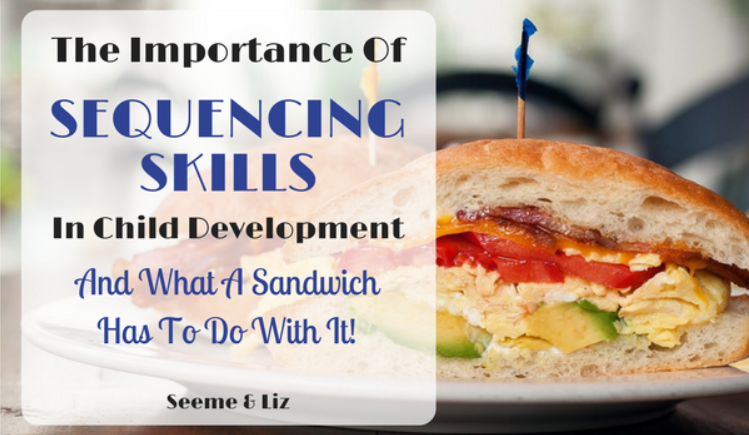Sequencing skills are extremely important in everyone’s day to day life but typically taken for granted.
Sequencing is an example of foundation skills I refer to in many of my articles.
I cannot stress enough how important it is for young children to learn “foundation” skills that they can use to build other skills on in the future.
Without these early skills in place children are left with gaps in their overall development.
I didn’t choose a picture of a sandwich as the main picture of this article just to make your mouth water.
I choose it because a sequence was used in order to create the sandwich!
I wrote an article a while back called Are Toys That Teach Kids How To Code Necessary In Today’s Electronic World? in which I state that these types of toys are not necessary for a child’s optimal development.
You may be wondering what that article has to do with this one about sequencing so I will get right to it.
Learn to code toys are essentially teaching children about higher level sequencing concepts.
But if a child doesn’t have the basic concepts of sequencing first, they are jumping all over the place.
So before you head out to buy the latest and greatest learn to code toy for your 3 year old, continue reading this article to learn how sequencing skills develop and why they are so important.
Once your child has a grasp on sequencing, then by all means try out one of these toys!
What Is Sequencing From A Language Development Perspective
Broken down into tiny parts, sequencing can be as minuscule as arranging sounds to form a word (the order obviously varies from one language to another).
For example, in English you would not start a word with a letter combination such as “Pdr”.
This may be appropriate in another language, but not in English. Children must learn this. Once this has been sorted out it’s time to figure out word order.
The sentences in this article are all made up of sequences.
If I wrote “kids for some sequencing challenging can be” you most likely would be able to figure out what I was trying to say, but if the whole article was written that way you would wonder what was wrong with me.
In order to arrange ideas, information and language (sounds and words) you must have some sequencing skills in place.
You can also think of sequences as steps to meet an end goal.
The goal of arranging sounds is to make a word, the goal of getting a plate, placing 2 slices of bread onto it, getting a knife and spreading butter onto the bread and then adding items like lettuce, meat and tomatoes is to make a sandwich.
Children also need sequencing in order to follow directions.
For example, “put away your dishes, then get your coat so we can head to the car. Don’t forget to close the door if you are the last one to leave!”
If a child is struggling with language development and sequencing they may remember what was said but have no idea what order to do the things in and get overwhelmed.
To someone with intact and developed sequencing skills this instruction could be given out of order, but you would still logically know what to do first, next, last.
There are many children who struggle with sequencing and these difficulties typically stem from issues with language development, executive function skills (e.g. working memory, processing speed, organization, etc.) or attention.
But I won’t get into that in this article.
Sequencing and Literacy
While I was practicing as a Speech-Language Pathologist I often worked on sequencing skills with 4 and 5 year olds. Any idea why?
The answer is in the heading right above this paragraph!
The ability to sequence is an important skill for comprehension, reading and writing.
If a child is unable to sequence a series of events it will be very difficult to understand the timeline of a story once they begin reading.
Complex Sequencing
This is the type of skill that someone working as a software developer would require.
You can’t go from not understanding basic sequencing to this kind of sequencing.
Unfortunately this kind of sequencing isn’t really taught in school as it is more complex.
Although I think it would really help many people to be taught this skill.
I stumbled on an interesting piece of research a while ago that inspired me to write this article.
The research focused on 15 year old students from 41 countries.
The researchers gave these students an assessment looking at the students’ capabilities in math literacy, science literacy and reading literacy.
But what they really wanted to see was how what students had learned in school transferred to the ability to solve real problems that they may encounter later on.
What they found was that students struggled to develop higher order sequences.
Sequencing Activities For Children
Below are some ideas for working on sequencing in playful ways for babies, toddlers, preschoolers and school aged children.
Babies
Signing, Talking and Reading
Do these three with your little one all day long to promote sound sequencing.
Once your baby is about 12 months old you may hear their first word.
By 18 months many are starting to combine words. Even with 2 word combinations there should be a first and last sequence.
For example, “drink milk” is an expected 2 word combination a child under 2 may say. But “milk drink” doesn’t sound quite right.
This is a good reason to try to use as grammatically correct phrases and sentences as possible, right from the start!
Toddlers and Preschoolers
Singing and Dancing
For toddlers you can practice sequencing through song and dance.
Sing a familiar song such as Old McDonald or If You’re Happy and You Know It.
As your child starts knowing what to expect leave out a word or action for them to fill in.
Or make up a few simple dance steps (3–5 ideally) and show them to your child.
See if your child can do the same thing with all steps in the correct order.
Take turns making up the steps with your child so they can have a turn giving you the directions.
Sequence Photos or Toys
Use basic concepts such as small, medium, big or short, taller, tallest to arrange objects or pictures.
A great idea is to find 3 pictures of your child, one as a newborn, one where they are learning to crawl and one where they can walk.
Have your child put them in order from “first I was born”, “next I crawled” and “last I learned to walk”.
School Aged Children
Story Sequencing
If your child is still learning to read you can do this with pictures.
By the age of 4–5 children should be able to sequence 4–6 events in a story.
You can make your own stories with photographs you have taken or download pictures to make your own story.
An example could be a child building a snowman.
Have 4–6 pictures depicting a child making a snowman.
Tell the story to your child and then mix up the pictures and ask them to retell it.
You can also talk about everyday routines.
For example, “tell me what you do to get ready for bed”.
This is why it is so important to narrate everything to your baby/toddler.
Once your child can read, cut out a few sentences of a story and have them put them in the correct order after hearing the story.
Or read a short story to your child (or let them read it if they are able to) and then ask them to retell the story in their own words.
Make a Snack
Ask your child what steps are needed to prepare a sandwich or bowl of cereal (something simple that they are capable of actually doing on their own).
For more information on sequencing head to Super Duper Inc. – they have great information on this important skill for parents that can be downloaded in pdf format!
Sequencing Is A Life Skill
The importance of sequencing skills in a child’s development should not be underestimated.
It’s one of those skills us adults often take for granted.
We sequence on auto pilot.
But without some of these “easy” sequencing skills in place at the right time of development it will be much harder to become proficient at the more complex sequencing skills that require critical thinking.
You can purchase pre-made sequencing activities like those shown below, but this isn’t necessary unless you are homeschooling or running a program for children or if your child has a known delay in sequencing ability.





